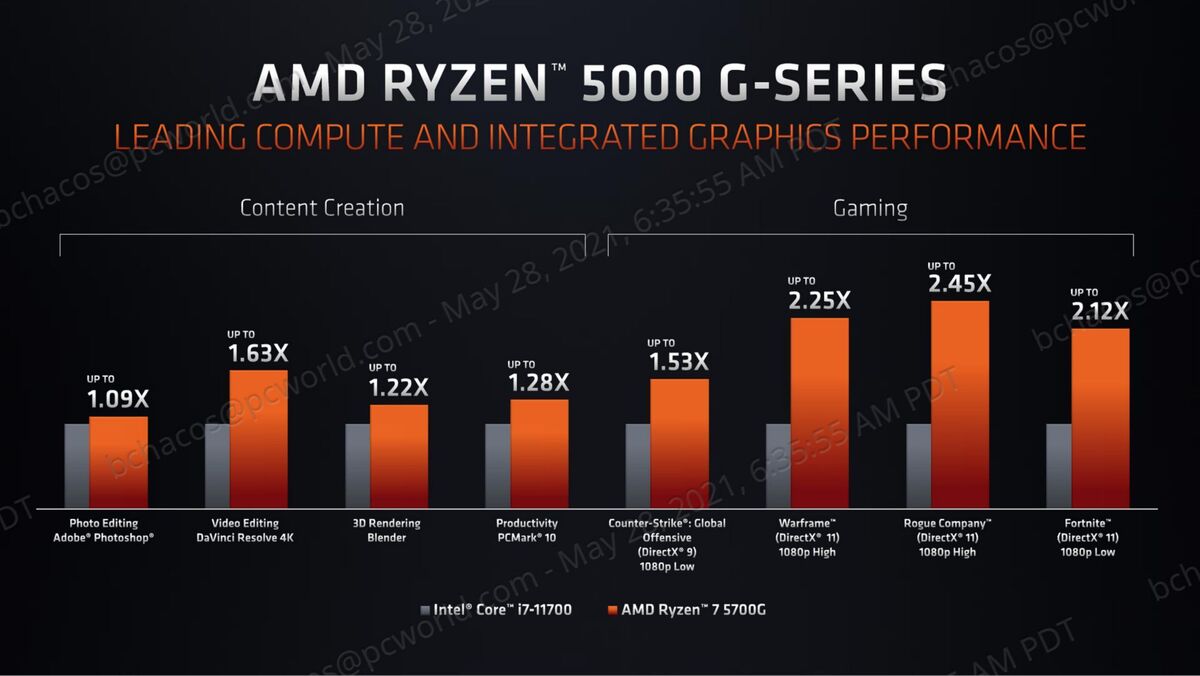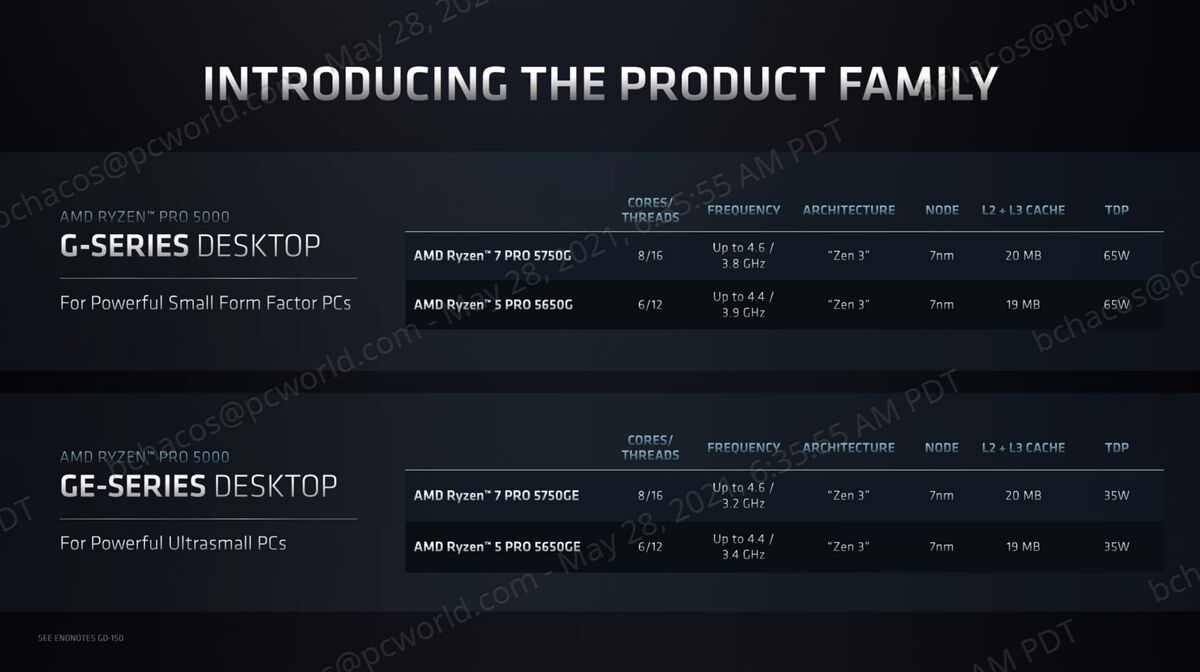Your prayers are being answered, DIY PC builders: During its Computex 2021 keynote, AMD announced that its hotly anticipated Ryzen 5000G APUs, which marry the company’s latest CPU cores with integrated Radeon graphics, will launch in just a few months, on August 5. But circumstances around the ongoing chip shortage mean these APUs don’t fill the same role as prior-generation models.
Previous Ryzen 2000G and 3000G APUs slotted into the low end of AMD’s processor lineups, offering four CPU cores and eight threads for prices ranging from $80 to $150 or so on the streets. This time around, however, AMD doesn’t plan on making its modest Ryzen 3 5300G APU available to the DIY market. Instead, we’ll be getting the $259 Ryzen 5 5600G and $359 Ryzen 7 5700G.
- Ryzen 7 5700G: 8 cores and 16 threads; 3.8GHz base and 4.6GHz boost clock; 8 Radeon Vega GPU cores at 2GHz.
- Ryzen 5 5600G: 6 cores and 12 threads; 3.9GHz base and 4.4GHz boost clock; 7 Radeon Vega GPU cores at 1.9GHz.
 AMD
AMDIn a briefing with PCWorld prior to the keynote, AMD’s Robert Hallock said these chips are intended to stand in as more affordable, non-“X” alternatives to the existing $300 Ryzen 5 5600X and $450 Ryzen 7 5800X in AMD’s kick-ass Ryzen 5000 lineup (though these APUs are built around the “Cezanne” CPU architecture that debuted in AMD’s also-kick-ass Ryzen 5000 Mobile chips). The Ryzen 3 5300G offered in prebuilt systems isn’t being offered directly to PC builders partly due to AMD’s decision to prioritize higher-end processors while silicon shortages continue to ravage the technology industry, Hallock said.
That’s disappointing news for gamers who might have been hoping to build a modestly priced Fortnite rig around a new Ryzen 3 APU, but if you’ve got the cash for them, the Ryzen 5 5600G and Ryzen 7 5700G fulfill a lot of the requests that enthusiasts have filed over Ryzen APUs. As we said in our original look at the Ryzen 5000G offerings, “While all previously available DIY Ryzen APUs topped out at four cores, AMD listened to the loud grumbles for higher-performance options with the Ryzen 5000G series, culminating in the fully loaded 8-core Ryzen 7 5700G. That’s overkill if all your hoping to do is game on the chip’s integrated graphics, but it’s welcome news indeed for people who need modest graphics performance and higher CPU performance for specific tasks.”
 AMD
AMD“People suffering through the global GPU crisis will be more interested in those Radeon GPU cores, however,” we said. “The Ryzen 5000G lineup still leans on AMD’s Radeon Vega 8 architecture, rather than the new RDNA 2 architecture found in the Radeon RX 6000-series graphics cards, which you can’t even buy. Still, the company says the Vega 8-based silicon should be much more potent than before. Both the CPU and GPU cores have been built using the 7nm manufacturing process, rather than the 12nm process found in previous chips, which helps unlock much higher frequency for the graphics. The older Ryzen 5 3400G’s Radeon cores topped out at 1.4GHz, but all of the new chips exceed those speeds, with the flagship cranking things up to a blistering 2GHz. That’s wild for integrated graphics.”
 AMD
AMDHow wild? During the briefing, Hallock shared a slide showing the 5700G running Rogue Company at a whopping 78 frames per second at 1080p resolution with High visual settings enabled. That’s killer performance for integrated graphics. Another slide showed the Ryzen 7 5700G whomping on Intel’s rival 8-core Core i7-11700 processor, which costs about $20 less, in both gaming and content creation tasks. The slide lacked actual gaming frame rates or content creation scores, however, only showing relative performance between the processors. AMD dominated.
Ryzen Pro 5000G and 5000GE
The new APUs are also being tapped for more serious work in the form of Ryzen Pro 5000G- and GE-series processors. G-series processors have a 65-watt TDP, while the GE-series variants run at 35W to slip into more space-constrained form factors.
 AMD
AMDThe specs for the Ryzen Pro 5000G models match the consumer-focused variants, but as the name indicates, Ryzen Pro chips come loaded with professional-focused features. You’ll find support for Secured-core PC technology, AMD’s Memory Guard encryption feature that protects against attackers if ne’er-do-wells manage to physically steal your computer, long-term support reassurances, and various tools designed to make imaging, deployment, and device management easier.
The onboard Radeon graphics will no doubt appeal to IT managers who need systems without discrete graphics cards as well. Non-APU versions of Ryzen processors don’t include integrated graphics, so they need to be paired with additional hardware to output video to a display. Ryzen Pro 5000G’s mixture of high, fast core counts and solid integrated graphics could wind up being a winner in workstations.
Look for Ryzen Pro 5000G chips to start shipping sometime shortly after the consumer versions launch.
Stay connected with us on social media platform for instant update click here to join our Twitter, & Facebook
We are now on Telegram. Click here to join our channel (@TechiUpdate) and stay updated with the latest Technology headlines.
For all the latest Technology News Click Here
For the latest news and updates, follow us on Google News.
